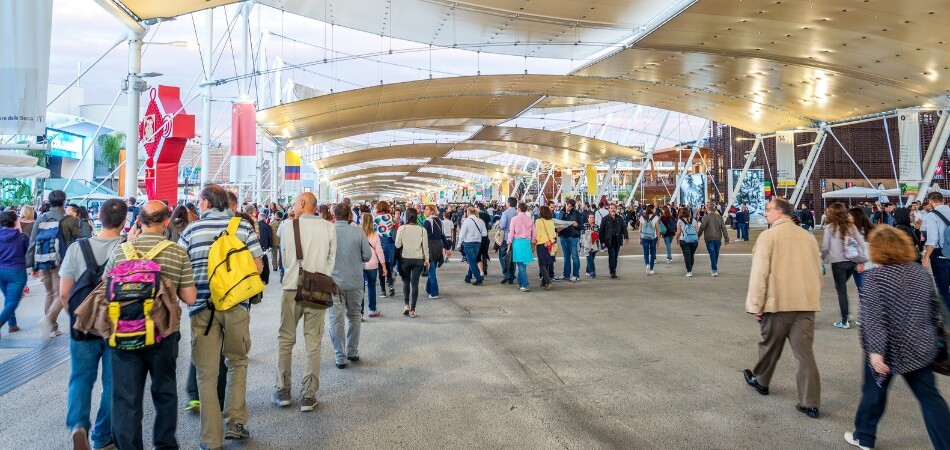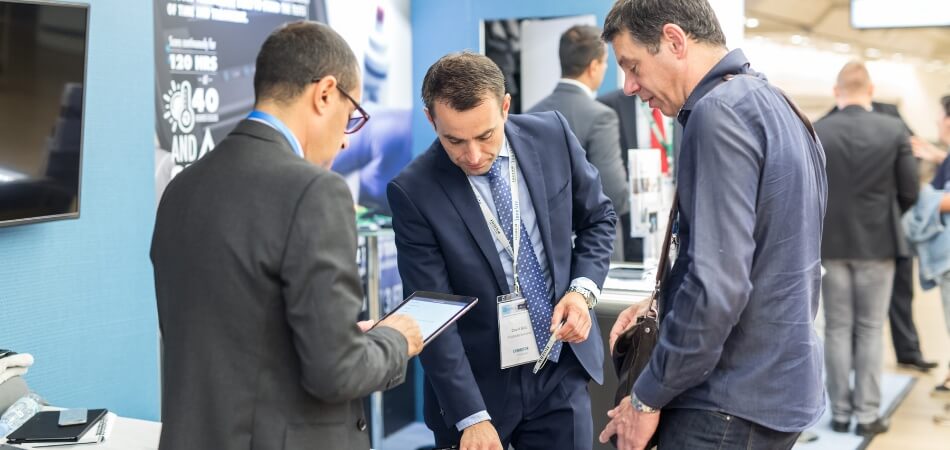Trade shows are essential for businesses, allowing them to display their products and services to potential customers and peers. The key to success at these events is having an effective trade show booth. But, what is a typical trade show booth?
A typical trade show booth is a temporary display space where businesses showcase their products or services to attract potential customers and network with industry professionals. It often includes signage, promotional materials, and product demonstrations.
In this blog post, we’ll explore trade show booths, what they’re all about, their common elements, and how they can boost business success. Join us as we uncover what makes a typical trade show booth special.
The Purpose of a Trade Show Booth
A trade show booth serves as a dynamic platform for businesses to engage with potential customers and industry peers. It’s a showcase space where products and services come to life, providing attendees with hands-on experiences and valuable insights.

By strategically designing and staffing their booths, companies can create an inviting atmosphere that attracts curious visitors. Booths play a pivotal role in fostering networking opportunities, allowing businesses to form connections that can lead to profitable partnerships or collaborations.
Furthermore, trade show booths act as powerful marketing tools, elevating brand visibility and recognition within a competitive market. The combination of eye-catching displays, informative materials, and interactive elements can leave a lasting impression on attendees, driving them to explore further and ultimately convert into loyal customers.
What Is a Typical Trade Show Booth?
A typical trade show booth is a short-lived exhibit area where companies present their products or services to engage potential customers and connect with industry peers. These booths usually comprise eye-catching signs, informative promotional materials, and live product demonstrations.
Trade show booths offer businesses a platform to leave a lasting impression on attendees and spark their interest. These spaces are meticulously designed to captivate visitors, with colorful banners, engaging graphics, and well-organized brochures that convey a clear message about what the company offers.

Moreover, product demonstrations at trade show booths allow companies to showcase the functionality and value of their offerings. These interactive presentations enable attendees to see, touch, and experience the products firsthand, helping them better understand the benefits and advantages.
In essence, a well-crafted trade show booth serves as a dynamic marketing tool, drawing in potential clients, fostering meaningful connections, and leaving a positive and memorable impression, ultimately contributing to the success of a company’s marketing efforts.
Key Components of a Typical Trade Show Booth
A typical trade show booth is a strategic space designed to showcase a company’s offerings, attract potential customers, and create lasting impressions. To create an effective trade show booth, several key components must be carefully considered and integrated.
Eye-catching Signage
Eye-catching signage is a paramount component of any trade show booth. It includes banners, posters, and digital displays that prominently feature the company’s name, logo, and a compelling tagline. The goal is to grab the attention of passing attendees and convey the brand’s identity and message at a glance.
Engaging Graphics
Engaging graphics plays a crucial role in drawing visitors closer to the booth. These visuals should be visually appealing, align with the company’s branding, and effectively communicate the products or services on offer. High-quality images, infographics, and illustrations can all enhance the booth’s overall appeal.
Informative Promotional Materials
Informative promotional materials, such as brochures, pamphlets, and product catalogs, provide attendees with detailed information about the company’s offerings. These materials should be well-designed, concise, and easy to browse, allowing visitors to take home valuable insights about the products or services.
Interactive Product Demonstrations
Live product demonstrations bring the booth to life and offer attendees a firsthand experience of the company’s offerings. These interactive presentations showcase product features, benefits, and usage, helping potential customers understand the value of the products and how they can meet their needs.
Engaging Booth Staff
The booth staff are a crucial component of a successful trade show booth. They should be knowledgeable, approachable, and enthusiastic about engaging with attendees. Staff members play a vital role in answering questions, initiating conversations, and forging connections with potential clients.
Comfortable Seating and Layout
Providing comfortable seating within the booth is essential to encourage longer interactions with attendees. Additionally, an efficient booth layout that allows for easy navigation and interaction is key. It should create a welcoming and inviting environment for visitors to explore and engage with the company’s offerings.
A successful trade show booth includes these essential elements: eye-catching signs, appealing graphics, informative materials, live product demos, friendly staff, and a comfortable layout. These elements help businesses stand out and connect with potential customers effectively at trade shows.
How a Standard Booth Design Can Drive Success in Achieving Trade Show Goals?
A well-considered standard booth design is not just a physical presence; it’s a strategic tool that can significantly impact a company’s success in achieving its goals at trade shows. It serves as the first impression, the brand ambassador, and the engagement hub for attendees.
Visibility and Branding
A standard booth design should prioritize visibility. It should incorporate the company’s branding elements, like logos and colors, prominently. This ensures that attendees can easily identify and remember the brand amidst the bustling trade show environment.
Engaging Aesthetics
An appealing booth design captures attention. Attractive visuals, graphics, and layouts can entice attendees to stop by and learn more about the company’s offerings. The booth’s aesthetics should align with the brand’s identity and message.
Clear Messaging
Clarity in messaging is essential. The booth design should effectively communicate what the company does and what sets its products or services apart. Simple and concise messaging ensures that attendees quickly understand the value proposition.
Functionality and Flow
An efficient layout is crucial. The booth design should facilitate easy movement for both attendees and booth staff. It should encourage natural engagement and provide areas for product demonstrations, discussions, and interactions.
Lead Generation and Data Collection
To achieve trade show goals, the booth design should incorporate mechanisms for lead generation and data collection. This might include digital tools for capturing attendee information or interactive elements that encourage visitors to express interest.
To sum it up, a well-planned booth design at a trade show can boost success. It grabs attention, looks inviting, shares the message clearly, and helps gather leads and data. This all leads to achieving trade show goals effectively.
Common Barriers You Can Face While Planning a Typical Trade Show Booth
Planning a trade show booth can be a complex endeavor, often filled with unexpected challenges. These barriers can impact the effectiveness and appeal of your booth. Understanding common obstacles is crucial for a successful exhibit.
- Budget Constraints: Limited financial resources can restrict your ability to create an impactful booth, affecting design, materials, and staff.
- Limited Space: Booth size limitations can make it challenging to showcase products effectively and engage with attendees comfortably.
- Design Challenges: Creating an eye-catching and functional booth design that aligns with your brand can be a daunting task.
- Logistics and Shipping: Coordinating logistics, including shipping, setup, and teardown, can be a logistical headache.
- Competition: Standing out in a crowded trade show environment with numerous competitors can be a significant challenge.
- Staffing and Training: Finding and preparing knowledgeable and engaging booth staff can be a barrier to effective interaction with attendees.
In conclusion, while planning a trade show booth, anticipating and overcoming these barriers is crucial for success. A well-thought-out strategy that addresses these challenges can significantly enhance the impact and effectiveness of your trade show presence.
Tips for Cost-Effective Booth Design and Setup
Designing a cost-effective booth for trade shows doesn’t mean compromising on quality or impact. Smart planning and creativity can lead to impressive results while staying within budget. Here are practical tips for achieving a standout booth design cost-effectively.

Opt for Modular Designs
Modular booth components offer flexibility and reusability. They’re ideal for creating different layouts for various shows. Investing in these versatile elements reduces long-term costs. Plus, they’re easy to transport and set up.
Focus on Key Brand Elements
Highlight your brand’s core message with simple, impactful design. Use your logo and brand colors strategically. This focused approach ensures a memorable and cohesive booth. It avoids unnecessary expenses on elaborate designs.
Utilize Digital Displays
Digital displays are a cost-effective alternative to printed materials. They offer dynamic content options and can be updated easily. This reduces the need for printed graphics for each show. Plus, they add a modern touch to your booth.
DIY Elements Where Possible
Engaging in some DIY for your booth can save costs. Simple elements like hand-crafted signage or decor add a unique touch. It also allows for customization that aligns with your brand. Remember, DIY requires time and creativity.
Rent Instead of Buy
Renting booth components can be more economical than buying them. It’s especially useful for items you won’t use frequently. This approach also offers the flexibility to try different designs. Renting high-cost items like furniture or AV equipment is practical.
In conclusion, achieving a cost-effective booth design is possible with smart strategies. Use modular designs for flexibility, highlight your brand clearly, incorporate digital elements, add your own DIY touches, and consider renting key items. These approaches can save money while keeping your booth creative and impactful.
Conclusion
A typical trade show booth is an essential component for businesses to stand out in competitive marketplaces. It’s not just a space for display but a strategic tool that can drive significant business growth. These booths blend creativity and strategy to captivate potential customers and industry peers.
When we consider ‘What is a typical trade show booth?’, it becomes clear that its success hinges on effective branding and engaging design. Overcoming challenges like budget limitations and space constraints is crucial. The right approach can transform these booths into memorable, impactful experiences for attendees.
Lastly, employing cost-effective strategies, such as using modular designs and incorporating digital displays, enhances a booth’s appeal while being budget-friendly. The essence of a well-planned trade show booth lies in its ability to showcase products and services compellingly, fostering meaningful connections, and leaving a lasting impression on its audience.


